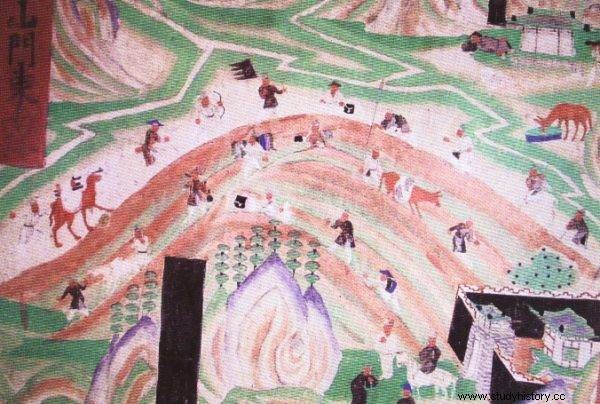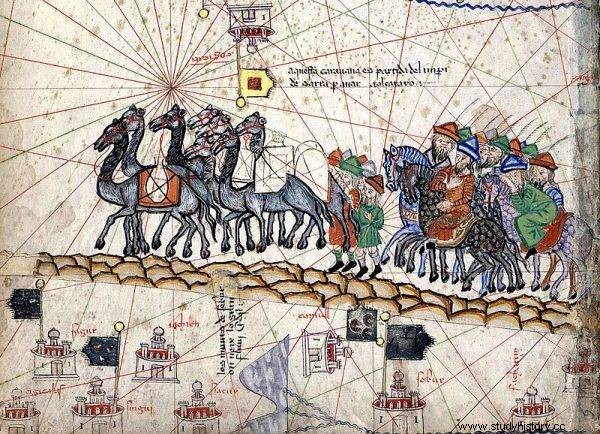This is where silk, paper and other civilization achievements of the Middle Kingdom reached Europe. On the other side - to China - there were, among others, perfumes or jewelery.
The name "Silk Road" was coined only by the German traveler and geographer Ferdinand von Richthofen in 1877. The trade route itself, however, is much older - it operated from the 3rd century BC. until around the 17th century. For 2,000 years, caravans and merchant carts traveling east and west provided valuable goods, but also civilization achievements and ideas . They left their mark on the peoples of South Asia, and also influenced the history of China and Europe.
Like silk
Extremely delicate, smooth fabric, obtained from silkworm cocoons, caused admiration on the Old Continent. By the time it reached Europe, silk was the fabric of emperors and sages for thousands of years . It also served as a painting base and material for the production of special screens for the printing method called screen printing.
In China, the ability to produce silk was already known to 3600 BC, i.e. at the very dawn of civilization. Around 2600 B.C.E. instead, damask production was started.
Legend has it that the silk was discovered by the wife of Emperor Huang Di, who lived in the years 2698-2598 BCE. He was supposed to ask his wife to check which pests are feeding on the mulberry trees in their garden. The Empress noticed that the insects that had taken over the trees were spinning white, shiny cocoons. She plucked one that had accidentally dropped into her boiling water. After getting it out of the hot liquid, it turned out that it was possible to pull a shiny thread from the cocoon . The woman wrapped the thread on a spool and hid it so that the secret of silk production would remain with the imperial court.

The name "Silk Road" was coined only by the German traveler and geographer Ferdinand von Richthofen in 1877. However, the trade route itself is much older
And it was true. For 2,000 years, China has kept the secret of making this amazing fabric . Thus, they maintained a monopoly on its production. There was a death risk for revealing the secret.
Only in II BCE - during the reign of Emperor Wudi - the Middle Country began to open up to the world. It was then that the imperial emissary Zhang Qian, traveling through Central Asia, gave the ruler the news he had heard about the peoples living further to the West, including about Persia and Rome. The news of intriguing civilizations caused such a stir at court that the emperor decided to defeat the nomadic confederation of the Xiongnu tribes in order to gain control of the trade routes leading to the West.
Apparently, the fame of silk began to develop in Rome after in 53 BCE. Then the Roman legions led by Crassus miserably lost to the Parthians at the Battle of Carrhae. After this defeat, Roman soldiers who survived the battle were to deliver to their homeland a story of an amazingly beautiful fabric from which the enemy's banners were made.
Also read:All roads lead to… history. Old and new Silk Routes
Egg smuggling
For hundreds of years, the Middle Kingdom, although it traded in silk, skillfully kept its secret. According to Procopius of Caesarea and Theophanes it was only at the turn of antiquity and the Middle Ages that the knowledge about the production of this fabric came to Europe , specific to Byzantium, where so far Chinese merchant expeditions have reached.
About 550 C.E. the silk "know-how" to the court of the Byzantine emperor was to be delivered by two monks who had previously visited the Middle Kingdom. They were for a generous fee to undertake smuggling silkworm eggs from China to Europe which they did too. They were to hide 26,000 precious eggs inside bamboo sticks, which they used to support themselves. They then traveled along all of South Asia to deliver the "cargo" to the imperial court.
Read also:Greek gods in China? Amazing find from 1500 years ago
The journey of Marco Polo
Christian and medieval Europe learned more about China only in the 13th century - from the Venetian merchant Marco Polo. It was he who in 1271 set off from Venice to Acre, through Asia Minor, Persia, Afghanistan and Pamir, got to Kasharia, from where he traveled along the Silk Road to the province of Gansu in northern China. Marco Polo set off on a journey at the age of 17 with his father, also a merchant who had previously been to Asia.
The expedition lasted a total of 24 years. They spent 17 years in China working, inter alia, for Kublai Khan, grandson of the great Genghis Khan . Marco Polo fell into the favors of the ruler who bestowed him with dignities. He was a court adviser, diplomat, emissary. For 3 years he managed the city of Yanju (Yangzhou) in Jiangsu Province in East China.

Marco Polo returned from the journey of his life in 1292.
Marco Polo returned from the journey of his life in 1292. He returned by sea, the so-called the sea's silk route , that is, a route along the land from the coast of the South China Sea, through the Indochina Peninsula and Sumatra, Ceylon, along the coast of India and the coast of Persia. In the area of the Strait of Hormuz in the Arabian Sea, he went ashore to reach Trabzon (Trapezunt) by land through Persia and Armenia. From here, in 1295, he brought his beautiful story about the riches of the Far East through Constantinople.
Read also:The most bizarre and macabre deaths of great travelers
Not only silk
Contrary to appearances, the name of the trail is a bit misleading, because the valuable fabric was not the main commodity delivered from China to the West. Paper was an extremely valuable product, as well as iron, spices, roots and minerals - especially jade . On the other hand, fruit reached China - incl. grapes, jewelry or perfumes.
At the end of the Middle Ages, Chinese merchants also brought their products to the Kingdom of Poland - to Krakow. Then, valuable goods were exported along the Vistula to the rich, merchant Gdańsk, and from there they could continue to the ports of Western Europe.
However, the Silk Road is not only valuable goods - it is also an exchange of technology and ideas. It was on this route between the 10th and 13th centuries that inventions such as the compass, gunpowder and a mechanical clock reached Europe.

For thousands of years, the land route to China "gave life" to the peoples of all southern Asia. The end of the significance of the Silk Road brought the development of sailing and great geographical discoveries.
For thousands of years, the land route to China "gave life" to the peoples of all southern Asia. The end of the significance of the Silk Road brought the development of sailing and great geographical discoveries . In 1498, the Portuguese, led by Vasco da Gama, discovered a sea route from India on their great galleons. It became the main trade route leading to this part of the world (before the Suez Canal was built). Another Portuguese, Ferdinand Magellan, circumnavigated Cape Horn reaching the Pacific Ocean. It was the Portuguese who founded the colony in Macau, China.
Thus, the sailors of Lisbon and Porto laid the foundations for the construction of a modern ocean trade system. In the 16th century, they controlled both the eastern and western sea routes to Asia. Their huge ships made their way to Macau - known as the Gateway to China, bringing goods from Europe and the colonies in Africa and America. On the way back, they were taking Chinese porcelain or just silk on board.
New Silk Road
With the spread of new ocean routes, the land route to China lost its importance. It was longer and more dangerous. In the 16th century, the Silk Road ceased to play an important role on the world trade map.
Nevertheless, it survived as an idea and to this day policymakers keep returning to its concept. Today - unlike in the 17th century - land is again faster than by sea (and goods are transported by air the fastest). A few years ago, the Chinese communist authorities expressed their readiness to build a "new silk road" from China to Europe.
Today, there are direct freight trains on this route - incl. to Poland. A direct freight train from the Middle Kingdom to Kąty Wrocławskie in Lower Silesia takes 14 to 18 days. It transports electronics, photovoltaic panels, machines, products purchased through popular platforms (e.g. Ali Express) and many other goods.
There are more initiatives to open the land route from China. In 2016, the country signed the UN convention that facilitates road transport. In turn, in 2019 the Russian authorities announced the construction of a motorway on the route from Belarus to China. The Russian section of this road is to be 2,000 km long, and the whole section through Belarus, Russia, Kazakhstan and China - 8,000 km. It is estimated that the road can be built within a dozen or so years. Perhaps one of the most important trade routes in the history of mankind is being reactivated in front of our eyes.
Bibliography:
- Laurence Bergreen: Marco Polo:from Venice to Xanadu. trans. Marta Dziurosz. Poznań:Rebis, 2008.
- Laurence Bergreen: Beyond the World's Edge . Poznań:"Rebis" Publishing House, 2005.
- Cummins: History's greatest mysteries - unknown events . Warsaw:Bellona Publishing House, 2009.
